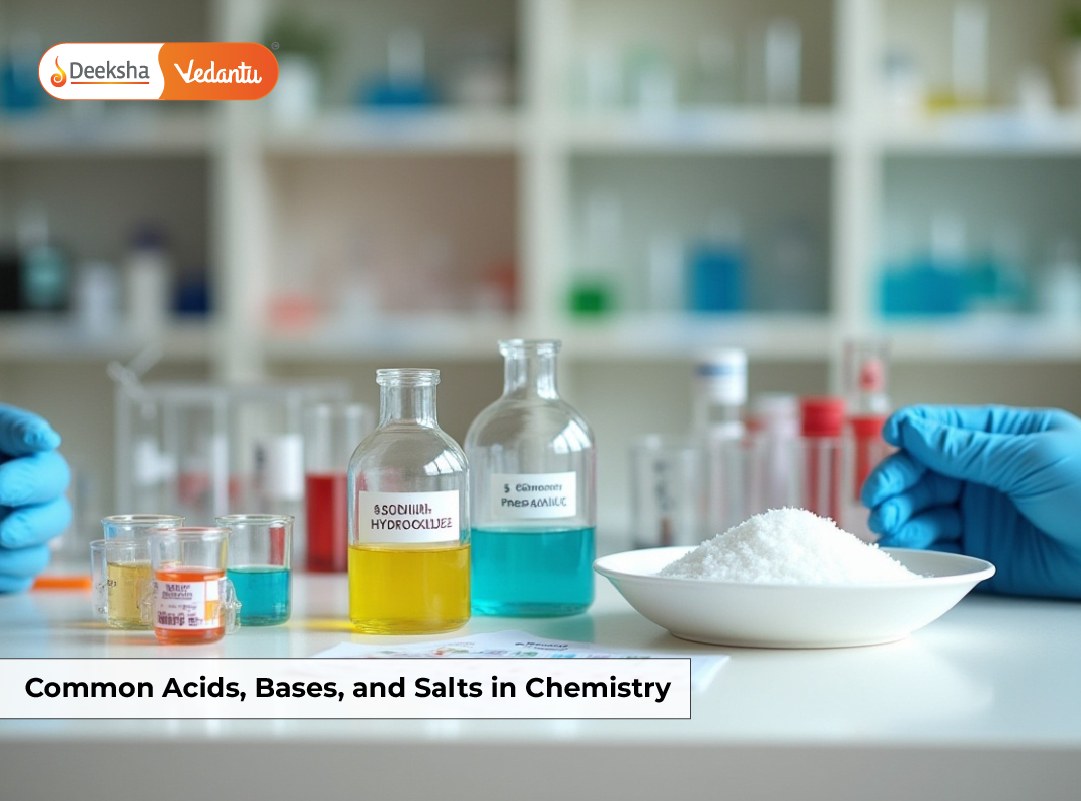Introduction
Acids, bases, and salts are not just terms from your chemistry textbook—they’re essential components of the world around us. From the sourness of lemon juice to the bitterness of baking soda, these chemical compounds influence everything from taste and cleaning agents to health remedies and industrial processes. Acids release hydrogen ions which cause a sharp, sour flavour, while bases release hydroxide ions, contributing to a bitter taste. These reactions are not limited to laboratories—they shape everyday phenomena.
Understanding their nature is essential for students exploring the foundations of chemistry. Not only do they help make sense of basic chemical reactions, but they also lay the groundwork for more complex topics in organic and inorganic chemistry. This guide aims to simplify these core ideas and build practical knowledge.
In this blog, we’ll simplify the key concepts of acids, bases, and salts, explain their properties, and provide a list of common examples you see around you. You’ll also learn about neutralisation reactions, pH values, and how to recognise these compounds using indicators. Plus, we’ll explain their role in biological processes, industrial applications, and daily chores.
What Are Acids, Bases, and Salts?
Acids:
Acids are substances that release hydrogen ions (H+) in aqueous solutions. They are known for their sour taste, reactivity with metals, and ability to change the colour of indicators. Acids play vital roles in the food industry, medicine, and even inside our own bodies.
Examples of Common Acids:
- Hydrochloric acid (
) – found in the stomach, aids digestion
- Acetic acid (
) – found in vinegar, used in food preservation
- Citric acid – found in citrus fruits, used in beverages and candies
- Sulphuric acid (
) – used in car batteries and fertilizer production
- Carbonic acid – found in carbonated drinks
Bases:
Bases are substances that release hydroxide ions () in water. They taste bitter, feel slippery to the touch, and are commonly found in cleaning products and industrial formulations.
Examples of Common Bases:
- Sodium hydroxide (
) – in soaps and drain cleaners
- Calcium hydroxide (
) – used in whitewashing and construction
- Ammonium hydroxide (
) – present in window cleaners
- Magnesium hydroxide – used in antacids and laxatives
- Potassium hydroxide – in alkaline batteries and soaps
Salts:
Salts are ionic compounds formed when acids react with bases in a neutralisation reaction. Depending on their composition, salts can be neutral, acidic, or basic. They are found in a wide range of applications from food seasoning to manufacturing.
Examples of Common Salts:
- Sodium chloride (
) – table salt
- Sodium carbonate (
) – washing soda
- Calcium carbonate (
) – found in chalk, limestone, and marble
- Potassium nitrate (
) – used in fertilizers
- Ammonium chloride (
) – used in dry cells
To explore more examples and detailed explanations, visit the Acids, Bases and Salts page.
Properties of Acids and Bases
Properties of Acids:
- Taste sour (e.g., lemon juice, vinegar)
- Turn blue litmus red
- React with metals to release hydrogen gas
- Conduct electricity in aqueous solution
- Have a pH less than 7
- Can cause skin irritation in strong concentrations
Properties of Bases:
- Taste bitter (e.g., baking soda, soap)
- Turn red litmus blue
- Feel slippery to the touch
- React with acids to form salt and water
- Conduct electricity when dissolved in water
- Have a pH greater than 7
- Can cause burns in high concentrations
Learn more: Understanding the Chemical Properties of Acids and Bases
Common Indicators Used
Indicators are special substances that help identify whether a solution is acidic or basic by changing colours.
Examples:
- Litmus Paper: Red in acid, blue in base
- Phenolphthalein: Colourless in acid, pink in base
- Methyl orange: Red in acid, yellow in base
- Universal Indicator: Provides a range of colours depending on the pH value
These are vital tools in labs and are commonly used in titration experiments, which help determine the concentration of an unknown acid or base using a neutralisation reaction. Indicators are also used in educational experiments to help students visually grasp acid-base behaviour.
pH Scale: Strength of Acids and Bases
The pH scale measures the concentration of hydrogen ions in a solution and ranges from 0 to 14:
- 0–6: Acidic
- 7: Neutral
- 8–14: Basic
Real-Life pH Examples:
- Lemon juice: pH ~2
- Vinegar: pH ~3
- Milk: pH ~6.5
- Pure water: pH 7
- Soap solution: pH ~9–10
- Bleach: pH ~12–13
Check out: How Strong Are Acid or Base Solutions
Examples of Neutralisation Reactions
Neutralisation is a chemical reaction in which an acid and base combine to form salt and water.
General Formula:
Acid + Base → Salt + Water
Real-Life Examples:
- Antacids: Magnesium hydroxide neutralises excess stomach acid
- Toothpaste: Basic compounds counteract acidic food residues
- Agriculture: Lime (calcium hydroxide) corrects acidic soil
- Bee stings (acidic): Treated with baking soda (a mild base)
- Wasp stings (basic): Treated with vinegar (a mild acid)
- Industrial waste management: Neutralising acidic or basic effluents before discharge
- Personal hygiene: pH-balanced soaps help avoid skin irritation
Explore the concept: What Do All Acids and All Bases Have in Common
Properties of Salts in Chemistry
Salts can be:
- Neutral (e.g.,
)
- Acidic (e.g., ammonium chloride)
- Basic (e.g., sodium carbonate)
The acidity or basicity of a salt depends on the strength of its parent acid and base. For example, a strong acid combined with a weak base results in an acidic salt, while a weak acid with a strong base yields a basic salt.
Other Characteristics:
- Soluble in water (most salts)
- Crystalline in structure
- Conduct electricity when molten or in solution
- Found in preservation (
), baking (sodium bicarbonate), detergents (sodium carbonate), and medicines (magnesium sulfate)
- Important in manufacturing processes (fertilizers, explosives, construction materials)
More details: More About Salts
Frequently Asked Questions
1. What is the difference between strong and weak acids?
Strong acids ionise completely in water (e.g., ), while weak acids only partially ionise (e.g., acetic acid). This affects their conductivity and reactivity.
2. Is all salt in the kitchen table salt?
No. While sodium chloride () is most common, other salts like sodium bicarbonate (baking soda), potassium iodide, and MSG are also present in food and medicine.
3. Can acids be safe to consume?
Yes, weak acids like citric acid, malic acid, and vinegar are commonly used in food and are safe in small quantities.
4. What happens when a base is too strong?
Strong bases like sodium hydroxide can cause chemical burns, eye damage, and serious injuries if not handled with care. Always use protective equipment in labs.
5. Can salts change the pH of a solution?
Yes, depending on their origin, some salts can make a solution slightly acidic or basic. For example, ammonium chloride produces a mildly acidic solution.
Conclusion
Understanding acids, bases, and salts opens the door to exciting areas of organic chemistry, industrial processes, environmental science, and health care. From household cleaners to life-saving medications, these compounds are part of our daily life.
By recognising their properties, knowing common acids and bases, and learning real-world examples of neutralisation reactions, students gain a solid foundation in chemistry that goes beyond memorisation. This knowledge forms the backbone of many applied fields such as medicine, food science, and engineering.
Keep exploring the world of chemistry with Deeksha Vedantu’s engaging resources and conceptual videos, like interactive animations and chapter-wise breakdowns designed to simplify learning. With practice and curiosity, mastering the fundamentals of chemistry becomes fun and meaningful.
Table of Contents















Get Social